If you’re around the Pacific Northwest for very long, one thing you ought to do is take a drive through the Columbia River Gorge. It is a very scenic trip that rivals any other that America has to offer. My family and I drove up the Gorge for Thanksgiving this week, on the heels of this year’s first major winter storm. I was reminded how beautiful the Gorge can be. I was also reminded how temperamental it can be (at least the weather).
The Columbia River Gorge is one of America’s largest river channels. It was formed during the last ice age when the ice dam that formed Lake Missoula broke, causing one of the biggest, most intense floods the world has ever seen. Water rushed out of the lake and across Eastern Washington, digging a network of deep channels in the earth. According to the Montana Natural History Center, the flow of water was 60 times greater than the Amazon River, the largest river in the world. Sixty times! The wall of water rushed through the region and left behind a trove of geological features. It created wonders such as Palouse Falls, Dry Falls (which were 3.5 times as wide and twice as high as Niagara Falls), the Channeled Scablands and Wallula Gap The waters spread out like a giant hand across Eastern Washington, coming together at Wallula and raging their way to the Pacific Ocean. It would have been quite a scene to see, assuming you were standing on ground above the flood plain.
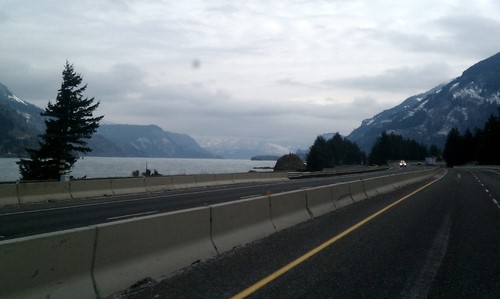 Quite the view
Quite the view
Driving the Gorge is no problem in the summer, but in the winter, you can run into some pretty treacherous road conditions. Warm, moist air off the Pacific hits the cold air east of the Cascade Mountain range, resulting in freezing rain or snow that quickly ices up the roads. The road can go from safe to dangerous in just a few minutes. This week, we thought the roads would be cleared enough by the time we drove through. It turns out we were wrong. The roads were in terrible shape from The Dalles eastward.
We left Portland heading at 9:30 in the morning on Wednesday, stopping at the truck stop in Troutdale for gas before hitting the road again. Outside of Troutdale, Interstate 84 moves down alongside the Columbia River. The river sits to your left and massive rock bluffs tower over the freeway to your right. Along these bluffs you see lots of small waterfalls spilling over the rocks and down to the ground below. I remember being excited as a kid every time we drove to Portland from Eastern Washington to watch for the waterfalls. Not only were they pretty, but they also signaled that we were nearing our destination. I don’t know what it is about waterfalls that is so interesting—the beauty of the water feathering apart as it falls, the roar of the water as it crashes against the rocks—but whatever it is, I still look for them each time we drive by.
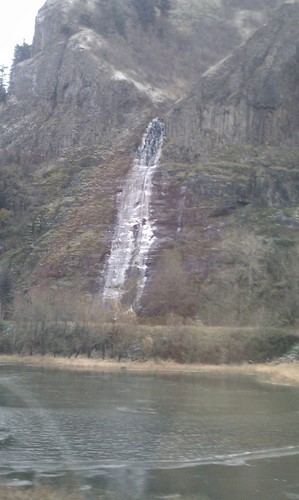 An icy waterfall
An icy waterfall
On this trip, some of the falls had nearly completely frozen against the rocks and you could barely see water running over them. Even the mighty Multnomah Falls (a quick day trip from Portland and a highlight for any family driving through the Gorge) had slowed considerably and left a thick deposit of ice where its spray had frozen onto the rock. It would have been fun to stop and get a better picture, but we were just starting a long journey, so we kept going.
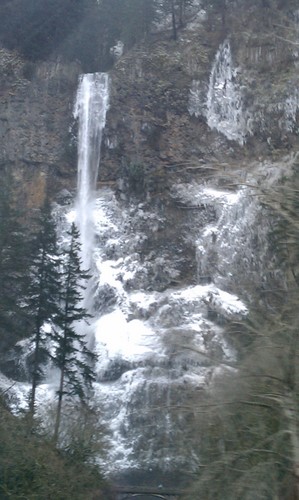 It's so cold that Multnomah Falls doesn't want to run
It's so cold that Multnomah Falls doesn't want to run
About an hour or so after we left Troutdale, we made it to the Dalles. Up to this point, the roads had been pretty good. Most of the road was wet pavement with the occasional patch of compact snow. However, once we reached the Dalles, road conditions changed for the worse. It was mostly compact snow and ice, and the trip became much less leisurely, especially for the driver (me). For the next ninety miles, I had to drive with extra focus, knowing that any sudden movement of the wheel could send us spinning into the median or into the car next to us. I usually enjoy driving, but under these conditions, not so much.
 Lots of trucks and lots of ice means you'd better pay attention
Lots of trucks and lots of ice means you'd better pay attention
As we moved farther up the Gorge, we began to see a lot of wind turbines. The Gorge acts as a huge wind tunnel, carrying strong winds through the Cascade Mountains to the Pacific Northwest’s interior. The area east of the Cascades is known for being particularly windy, something windsurfers have known for years. Hood River and the Dalles are major windsurfing destinations. More recently, the Gorge has become a site for massive turbine farms that produce many megawatts of wind-powered electricity. You see them on both sides of the river as you drive up the freeway. There has been a significant debate about whether there should be turbines in a National Scenic Area, but for now, the debate has been won by the wind power advocates.
Despite having to focus carefully on the road, it was still hard to not enjoy the beauty of the countryside as we traveled. This was the first time I remember driving up the Gorge right after a snowstorm (I remember driving up one time during a storm, but that’s another story). The towering mountains and the rolling hills looked like they were covered in a thick, white linen that smoothed over some of the jagged basalt rock formations. In the few places where the sun poked through the clouds, the hills glowed like fine porcelain under the bright lights of a downtown shop window.
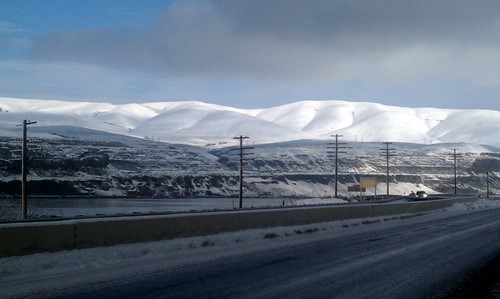 The giant white pillows of Eastern Washington
The giant white pillows of Eastern Washington
Although it seemed like it took forever, it only took us one extra hour to reach our destination because of the road conditions. We made it to Touchet (near Walla Walla) safe and sound, and it was a huge relief to get out of the car and relax. The next time we decide to travel up the Gorge, I doubt we will be so quick to follow a snowstorm.
Here are a few more pictures of our trip.
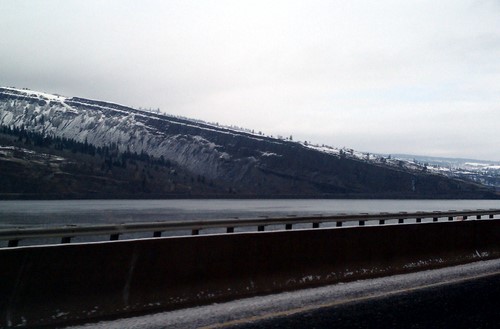 One of the unique geological formations you see driving up the Gorge
One of the unique geological formations you see driving up the Gorge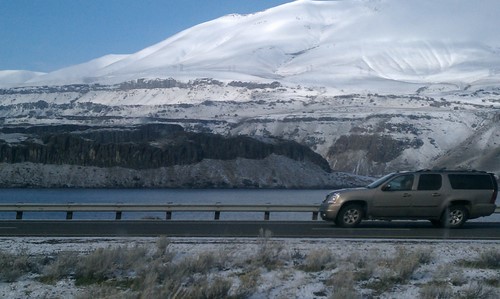 The hill and the SUV echo one another
The hill and the SUV echo one another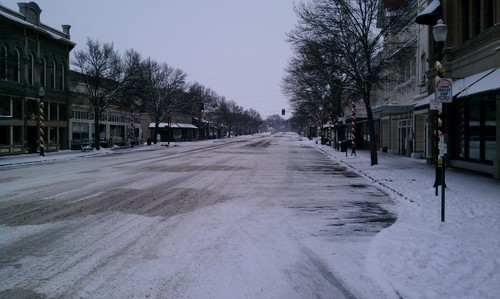 Not much going on in downtown Walla Walla on Thanksgiving morning
Not much going on in downtown Walla Walla on Thanksgiving morning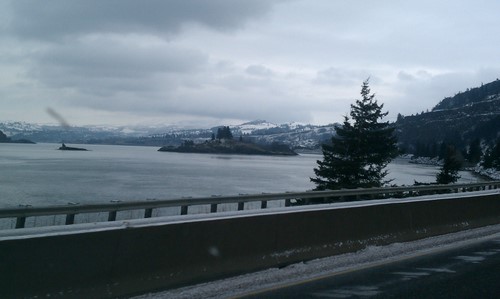 One more Gorge shot
One more Gorge shot